Space rocket or motorcycle? Truthfully, the Voxan Wattman that’s set to attempt the FIM land speed record for electric motorcycles is a little bit of both. This spaceship on two wheels is scheduled to attempt a new world speed record in July of 2021 on the Salar de Uyuni salt flat in Bolivia. The rider on board of this streamlined electric motorcycle will be none other than six-time world champion Max Biaggi. The Italian is no stranger to speed, having spent his career on the fastest racebikes in the world, but attempting a land speed record while completely encapsulated in the machine required a serious shift in mentality.
For one, Biaggi has to forget the way he used to ride, moving his body on the bike, and set aside his natural instinct to control everything and simply trust the system to extract maximum power from the machine designed with just one target in mind: to be the fastest electric bike on earth. The body of the rider was also a key element in the aerodynamic design; even a scan of Biaggi’s body was submitted. The result is an aerodynamics study so specific that only the Italian MotoGP and World Superbike world champion can ride this bike.
To build the Wattman, French brand Voxan started the project totally from scratch, guided by the desire to innovate. Part of the Venturi Group, and committed to the FIA Formula E Championship since its first season in 2004, Voxan knew it could count on the experience of Franck Baldet, the project’s technical director.
“The Wattman is an entirely new concept with 100-percent new parts, all designed and projected in house,” explains Baldet, former team coordinator of the Venturi Formula E team and, before that, Ferrari senior performance engineer. “We mainly used our know-how from Formula E. In fact, the concept and the pieces [of the Wattman] are closer to a car rather than a motorcycle.”
The challenge was to find parts that offered the best possible power-to-size ratio, since range is not a priority in a world speed record attempt. With 1,470 cells (and a weight of 140 kilograms, almost 309 pounds), the Voxan Wattman’s battery delivers 317kW (or 431 hp) of nominal power, with a capacity of 15.9kW.
Innovation and design were the guidelines for the project. “The speed record is a matter of power, power that you lose due to aerodynamics and power that you gain with acceleration, so you need to find a balance,” Baldet continues. “We focused on two main points: drag (aerodynamics) and stability at high speed. We were aiming to have the smallest possible projected area, but with a long wheelbase and a large rake, so the rider would be positioned as low as possible. We then identified a target speed based on the existing record, which was originally 327.6 kph (203.56 mph), but which was set at just over 329 kph (204.48 mph) by Ryuji Tsuruta, riding a Mobitec EV-02A in the autumn of 2019. That made no difference to our road map, as we were already aiming for a minimum of 330 kph (205.05 mph).”
The very low-grip track of the Bolivian salt flat and the altitude (the Salar de Uyuni lies 2.27 miles, nearly 12,000 feet, above sea level) also represented yet another aerodynamic challenge to the Voxan engineers. “We were able to do aerodynamic calculations up to more than 149.1 mph. Above that speed, we were getting into uncharted territory, but we learned other things from our track testing, and the thousands of computer simulations we did. On a very low-grip track, the slightest deviation can have very significant implications for stability. That’s why the design and an aerodynamic profile of the motorcycle are so important. For good aerodynamic efficiency, there is no radiator on this bike so [instead] there is a sort of tank [containing] dry ice to cool the vehicle as in Formula E. The difference here is that this tank is inside the bike.”
Sign up here to receive our newsletters. Get the latest in motorcycle reviews, tests, and industry news, subscribe here for our YouTube channel.
As for the altitude, that doesn’t affect the power of an electric bike, but it influences the aerodynamics. “In a way it helps because there is less friction on the bodywork, but on the other hand it reduces the vertical aerodynamics,” the project leader explains. “In this case, the Formula One technology was very helpful because it’s all about a balance between drag and vertical load.”
In order to maximize all the power, the Voxan engineers worked closely with Michelin to optimize the traction and the speed. “There are no existing tires that are homologated to reach such high speed,” Baldet relates. “All tires are homologated up to 350–360 kph on a MotoGP bike, so it should be okay for our speed record. We studied the behavior of the tires on the salt and at very high speed.” In addition, the tires had to deal with the 140 kilos (309 pounds) of the battery pack and a total bike weight of more than 300 kilos (661 pounds). “Because of the power we are obliged to deliver (270kW), the bike is much heavier than a MotoGP machine, [and] on top of the battery weight, we had aerodynamics that add extra load on the bike. But unlike MotoGP, we don’t need to accelerate hard because the grip is so low, or to brake hard, because we don’t need to turn.”
In addition to its futuristic carbon fairing, the Voxan Wattman boasts some other special technical characteristics that set it apart from conventional motorcycles. On two wheels, stability is key, so to maximize the distance between the front and rear wheels (to create a longer wheelbase), the engineers designed a double-wishbone front suspension rather than a telescopic fork. This keeps both sides of the wheel clear, a practical solution that helps lower drag while allowing for quicker and easier replacement. The bike is steered by a link and a swingarm, allowing the rider to sit further back and also lowering the machine’s center of gravity. The chassis is made from aerospace-grade steel, while the running gear and wheel rims are aluminum.
“There is no front brake,” Baldet continues. “Firstly, it’s better aerodynamically at high speed, but also on the vast salt flats it takes quite a while to accelerate (due to the low-grip surface) and we have plenty of room to slow down. In addition, front-wheel braking at very high speeds on a salt flat can unbalance the motorcycle and cause a fall. We aren’t using a parachute, but the rider does have a rear-wheel brake, which he controls with the left handlebar grip, and also engine-braking controlled by a small lever on the right handlebar grip.”
The first question Max Biaggi asked the Voxan engineers was about power, but he soon discovered that the key to riding this bike was something else. Can you imagine riding a motorcycle that is not designed to turn? “Max will ride the most powerful bike he has ever piloted, but he is also being asked to radically change his style and approach,” confesses Baldet, the project leader. “A rider is used to controlling everything. Here he is asked to trust the system.… He has to stay in one position for a few minutes—[one] that is designed for aerodynamic purposes, not comfort—until we communicate to him on the dashboard that he can brake.”
The rider in fact becomes one with the bike, to the extent that the bodywork was designed according to Biaggi’s body shape. “We scanned Max’s body and we made a complete model with the exact length of his legs, arms, and body shape. Biaggi visited Voxan’s headquarters in Monaco so we could run tests aimed at finding an optimized body position for aerodynamics.… His body is inside the bike. The bike is so tailor-made on his body that he is the only one who can ride this bike.”
The first test was not so easy, but Biaggi adapted quickly. “Max has a lot of experience, and we only gave him one piece of advice: Forget that you are riding a motorcycle and believe in the system to extract the maximum performance,” Baldet says. “Max liked the electric motor’s braking characteristics a lot. For him it was very intuitive. Together we also developed a light that calculates the acceleration, the distance required for the record, and we developed a strategy to inform him when he can brake with confidence once the necessary distance was covered.”
In addition, Biaggi had to learn something unnatural: remaining still to go fast. “The seating position is very different from a conventional motorbike because the center of gravity is very low. He is not allowed to move. This is something he had to adapt to because he is so used to moving his body on the bike…[but here] the challenge is to hold the position for a few minutes without moving.”
The high-speed tests were carried out on airport landing strips in France. The next adventure however, will be in the Salar de Uyuni salt flat in Bolivia.










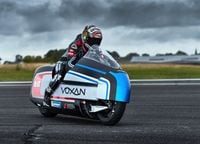
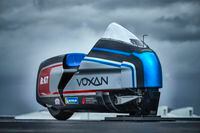
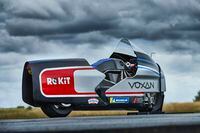
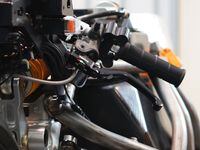
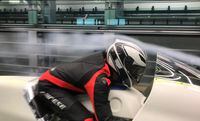


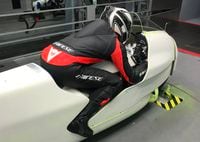
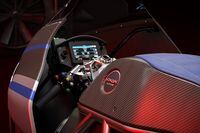
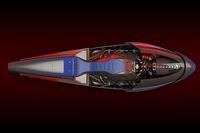
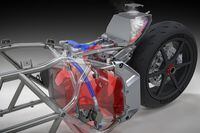
/cloudfront-us-east-1.images.arcpublishing.com/octane/UFG652C27BDBFPK42TDAJ5CMX4.jpg)
/cloudfront-us-east-1.images.arcpublishing.com/octane/AUE3NFVRRZDSBIDVUGIYIDQNUI.jpg)
/cloudfront-us-east-1.images.arcpublishing.com/octane/LYR62CH2WNBMHJJVXVATZHOUE4.jpg)
/cloudfront-us-east-1.images.arcpublishing.com/octane/RBCTRGBQYBDK7A6XPG3HKPS7ZQ.jpg)
/cloudfront-us-east-1.images.arcpublishing.com/octane/MQXQRYMZVBCWJIRYP3HEN3SHVE.jpg)
/cloudfront-us-east-1.images.arcpublishing.com/octane/TSPODNNEWRDSVJGUCNQTDG4ADI.jpg)
/cloudfront-us-east-1.images.arcpublishing.com/octane/X5TB7BDV4BA2RPSY54ZGK27RP4.jpg)
/cloudfront-us-east-1.images.arcpublishing.com/octane/REUHOJXRDBGZ5IHBYZCCBCISPA.jpg)
/cloudfront-us-east-1.images.arcpublishing.com/octane/52LGJTCKBFEHDF7S7H4CVUIMGM.jpg)
/cloudfront-us-east-1.images.arcpublishing.com/octane/YMWAIPIPSJAOXOU3QMJMGH37OM.jpg)


/cloudfront-us-east-1.images.arcpublishing.com/octane/EJ6KZRGAYBCVXNL2PJXL37UVWQ.jpg)
/cloudfront-us-east-1.images.arcpublishing.com/octane/AAN4TI76M5H5JMUVEIGASWXBDU.jpg)
/cloudfront-us-east-1.images.arcpublishing.com/octane/P3RXD2UCPFF37CMB7CHPVKXORY.jpg)
/cloudfront-us-east-1.images.arcpublishing.com/octane/VZEG2EJI2RDFZNHLRZMU56MD3Q.jpg)
/cloudfront-us-east-1.images.arcpublishing.com/octane/GVJQO5FFOFBWNGODOBRB4FBAW4.jpg)
/cloudfront-us-east-1.images.arcpublishing.com/octane/BIVAK2SFIBDJJM25E7I5VU2FJE.jpg)
/cloudfront-us-east-1.images.arcpublishing.com/octane/CH5VX52UG5CFHOVH5A6UYEFWWA.jpg)
/cloudfront-us-east-1.images.arcpublishing.com/octane/ZVGJNGZRU5C33N7KN23BBFKSC4.jpg)

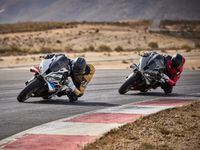
/cloudfront-us-east-1.images.arcpublishing.com/octane/CZ5OM3E43ZEXJHY7LCYXCHLIKI.jpg)
/cloudfront-us-east-1.images.arcpublishing.com/octane/DF5T4K5KPZFJXFCTGPYR77PKJM.jpg)